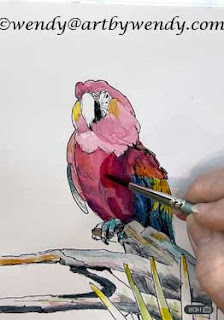Do you Golf? Curl? I do. Both.
In the winter I am busy curling. But when the sun shines I am ready to head for the greens.
It's been my life for many years.
 |
| Sketchbook Activity: Bennet's Point, Vancouver Island, BC |
No, I am not a Scratch Golfer nor a Curler that plays the circuit. But I love the games and I love the energy. I am pretty good with both but of course always obsessed with making 'that great shot'!! So, yes, I am open to new adventures and ideas to up my game.
A few weeks ago I had attended a 2 day workshop with Swapna Das. (Instagram: @kosen_rufu_artist) - Mastering the Art of Charcoal: A Creative Drawing
Workshop. She has awesome ideas for drawing and so I knew I would find something there to up my Art Game. And I did.
 |
| Reference for Bennet's Point Painting |
It started with a quick Warm Up.
I know, you have heard that before, but bare with me. Swapna had a few different ones, and this particular one really resonated with me.
Look at your reference, whether it is real life or a photo and make a quick sketch of the MASS in black and white. No detail. Just shapes. Make it big. Close to the size your final picture will be. If it is Value 5 or more it is black. If not just leave it white. Work quickly. You only get 2-3 minutes.
 |
| A 2 minute study to grab the darks |
Now stop!! . . . Step back. . . . . Evaluate.
Are the shapes interesting? Do you need to group some of them? What does the negative space look like?
I found several things happened at this point.
1. I became more familiar with my subject and my plan for my painting
2. I could see where I needed to make changes to my composition
(Ok, I do admit I snuck a little light smudges in the back for the horizon. But I really did try and just do the darks)
 |
| Capturing the line and shadows |
Step 2: Capture the line
Now here, you will spend more time. Using a pencil or pen, capture your plan with a line. Take 5-8 minutes and set up the shapes. Outline the shapes and their relationship to each other.
As you can see I didn't stop there with my line drawing. I went one step further and added detail and shadows. I wanted a closer look at how to deal with the foreground. (As adults, we definitely have a hard time faithfully following the rules. 🙄 )
At this point you will notice:
1. If your composition is really working.
2. You are way more familiar with your subject
3. The black and white masses help you understand how to deal with the values in those nebulous areas. In my case, the foreground below the tree.
4. How to set up the values in the mid and foreground areas. When I looked at mine I felt I had a great sense of depth in my drawing.
 |
| Bennet's Point, Vancouver Island, BC |
Step 3: Get Down to Business
Time to paint your picture. You will find as you paint that your process will now be slightly different. You will be faster, have a clearer plan of how to proceed. And a place to check that your are on track.
I found as I worked away, I was flipping back to my studies: checking my values to see if they were right; looking at my colour choices to see if they should be warmer or cooler; making sure I was grouping shapes as they should be. It was nice to have something to refer too.
 |
| A close up view of the foreground. |
As a follow up, I made a grayscale version of the picture for your to look at. I found it interesting to compare it with my line drawing and mass sketch.
 |
| Grayscale version of finished Bennet's Point |
Take-Aways:
1. It definitely helped me keep control of my values in the foreground.
2. I found I was able to group my darks more affectively.
3. I felt I found an interesting pattern for the branches at the bottom of the tree. That was a very tricky area.
Would I do all of this for every picture? No. But I certainly like the idea of creating a 'Black and White sketch of the Mass'. I usually do some kind of a value study for all my work and this really seems to fit right in with my process.
Take a picture and try it. It's your own DIY Painting and Drawing Lesson.
Taking Registrations for my Spring/Summer Events:
- Join me in the Shuswap for a 4 Day Outdoor Sketching Art Retreat hosted by Joanne Denis, June 20-23, 2025. I will be the instructor. This is an all inclusive: food, instruction, accommodations and drive from Lower Mainland. $350-$600 depending on the room choices. www.aventurasbc.ca
- Create Your Own Adventure - Let's go Outdoor Sketching Grab a friend or 2 and let's go. 2.5 hr $65ea. Contact me to set up a date. Location: Lower Mainland
- Save the Date: next set of 3 Zoom classes Thursdays, October 9, 16 & 23. Enhancing Your Drawing & Painting Skills. New focus for each set of classes
Original work, Commissions, Private Drawing Lessons, Prints and Cards of her Work,
Be sure to like and share my posts. You won't miss a single post if you Follow by Email Have a great Artful Day,









-s-1556.jpg)




.jpg)


























